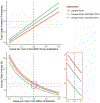Case reduction and cost-effectiveness of the RTS,S/AS01 malaria vaccine alongside bed nets in Lilongwe, Malawi
- PMID: 32362527
- PMCID: PMC7282487
- DOI: 10.1016/j.vaccine.2020.04.031
Case reduction and cost-effectiveness of the RTS,S/AS01 malaria vaccine alongside bed nets in Lilongwe, Malawi
Abstract
Background: RTS,S/AS01, the most advanced vaccine against malaria, is now undergoing pilot implementation in Malawi, Ghana, and Kenya where an estimated 360,000 children will be vaccinated each year. In this study we evaluate RTS,S/AS01 alongside bed net use and estimate cost-effectiveness.
Methods: RTS,S/AS01 phase III trial and bed net prevalence data were used to determine the effect of vaccination in the urban/periurban and rural areas of Lilongwe, Malawi. Cost data were used to calculate the cost-effectiveness of various interventions over three years.
Findings: Since bed nets reduce malaria incidence and homogeneous vaccine efficacy was assumed, participants without bed nets received greater relative benefit from vaccination with RTS,S/AS01 than participants with bed nets. Similarly, since malaria incidence in rural Lilongwe is higher than in urban Lilongwe, the impact and cost-effectiveness of vaccine interventions is increased in rural areas. In rural Lilongwe, we estimated that vaccinating one child without a bed net would prevent 2·59 (1·62 to 3·38) cases of malaria over three years, corresponding to a cost of $10·08 (7·71 to 16·13) per case averted. Alternatively, vaccinating one child with a bed net would prevent 1·59 (0·87 to 2·57) cases, corresponding to $16·43 (10·16 to 30·06) per case averted. Providing RTS,S/AS01 to 30,000 children in rural Lilongwe was estimated to cost $782,400 and to prevent 58,611 (35,778 to 82,932) cases of malaria over a three-year period. Joint interventions providing both vaccination and bed nets (to those without them) were estimated to prevent additional cases of malaria and to be similarly cost-effective, compared to vaccine-only interventions.
Interpretation: To maximize malaria prevention, vaccination and bed net distribution programs could be integrated.
Funding: Impacts of Environment, Host Genetics and Antigen Diversity on Malaria Vaccine Efficacy (1R01AI137410-01).
Keywords: Africa; Bed nets; Cost-effectiveness; Malaria; Malawi; Vaccine.
Copyright © 2020 Elsevier Ltd. All rights reserved.
Conflict of interest statement
Declaration of Competing Interest The authors declare that they have no known competing financial interests or personal relationships that could have appeared to influence the work reported in this paper.
Figures




References
-
- World Malaria Report 2018. S.l.: World Health Organization; 2019.
-
- First malaria vaccine in Africa: A potential new tool for child health and improved malaria control. World Health Organization; p. 4.
-
- National Malaria Control Programme - NMCP/Malawi and ICF. 2018. Malawi Malaria Indicator Survey 2017. Lilongwe, Malawi: NMCP/Malawi and ICF; Available at http://dhsprogram.com/pubs/pdf/MIS28/MIS28.pdf.
Publication types
MeSH terms
Substances
Grants and funding
LinkOut - more resources
Full Text Sources

